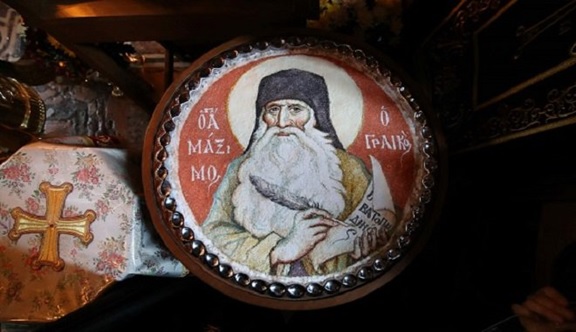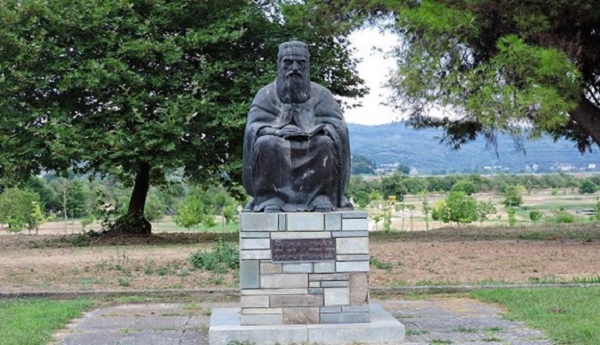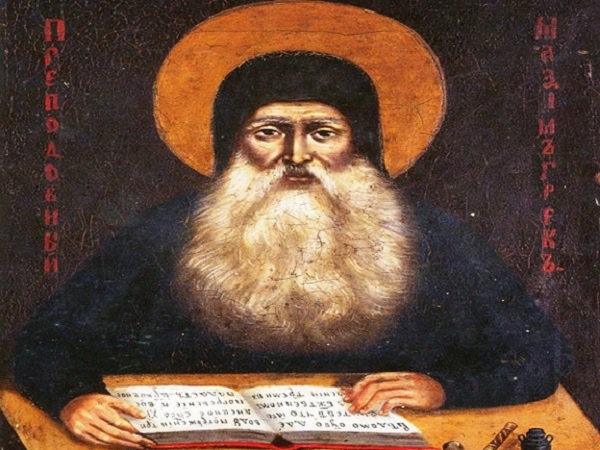The Miracles of Maxim the Greek
6 February 2019When Saint Maxim fell asleep in the Lord, he was buried at the north-eastern corner of the church of the Holy Spirit, which ‘had been erected by Tsar Ivan Vasilyevich IV [the Terrible] in commemoration of the conquest of Kazan’, within the Lavra of Saint Sergei.
After Saint Maxim’s death, many people paid their respects to his holy relics. According to a chronographer of old, he was called a great teacher and prophet. The people of Russia considered him ‘a new confessor and martyr for the truth’. They honoured him as a saint, ignoring the condemnatory judgements of the Synods of 1525 and 1531. In honouring Saint Maxim, Metropolitan Platon of Moscow writes that ‘he died at a great age and was buried with much reverence. He is considered a great figure of the Church, who was glorified with sanctity’. Metropolitan Platon had a reliquary made, with a cupola, and in 1833, the locum tenens of the Lavra of Saint Sergei, Archimandrite Antony, built a chapel over his grave.

From the middle of the 16th century, brief Lives of Saint Maxim the Greek began to be written. As information was gathered concerning his life, these accounts fell into two categories: the brief and the detailed. At the same period, various narratives concerning his miracles made their appearance and icons started to be painted. Hymns and troparia were written, praising his virtues and telling of his arrival in Russia from Greece, ‘from the east to the north’, in order to dispel the mists and bring light to the deep darkness.
In the first icons (from the 16th/17th centuries ), he’s depicted as a sage, but later (17th/18th centuries) with a halo, as a ‘holy Father’ of the Russians. He’s represented as having a broad beard, white hair, and holding a book or scroll on which is written the phrase: ‘Faith without works is dead’, which was interpreted as a pointed reference to the formalism of the clergy, the concentration of great wealth in the monasteries and also the maladministration on the part of the Russian ruler.
In 1564, a few years after his death, the saint was depicted on the walls of the narthex of the Blagovenskij church, in the Kremlin, among the philosophers of ancient Greece. This honour had never before been granted in the history of Russia, and has never been repeated since.

After his demise, the saint appeared to some of his closest friends, either to give them his blessing which they hadn’t managed to receive before he fell asleep in the Lord or to tell them that he was in the kingdom of God. To others he announced their departure from this world, as was the case with the monk Nikodim.
Some pilgrims to his grave told of their miraculous escape from enemies who had attacked them. ‘On the way, we were attacked by Turkish soldiers who wanted to strike us down. We called on God’s help and our blessed fathers, Sergei, Nikon and that new one, Maxim the Greek. All of a sudden, our enemies were dispersed’. They described Saint Maxim as being ‘of a great age, with a large, round beard’.
Many miraculous cures were reported by people suffering from a variety of illnesses. Sixteen years after the demise of Saint Maxim, Knyaz Alexey Ivanov Voronichsky, who was very ill, was cured by eating the kollyva blessed on the day of the saint’s commemoration.
In 1561, at the time of Patriarch Nikon, someone came to the Lavra of Saint Sergei, in order to honour a vow they’d made. After the paraclitic canon had been sung, the man was tired and sat down on one of the slabs covering a grave. Suddenly a force ejected him powerfully and he hurt himself badly. He managed to get back and asked the brethren whose grave it was. ‘The monk Maxim the Greek’s’, they answered. The man asked forgiveness of the saint, kept an all-night vigil to him and became completely well again.
A servant named Ivan didn’t believe in this particular miracle and disdainfully sat three times on the grave. Three times he was cast off and his face was badly damaged. He recognized his error and, turning to the icon of the Lord, begged His forgiveness. He fell asleep and saw an unknown monk praying to the Lord. He asked who he was and the answer came: ‘I’m Maxim the Greek’. Ivan then begged his forgiveness. Saint Maxim demanded angrily: ‘Why did you dishonour me? You’d heard, that very day, that somebody else was struck for sitting on my grave. You’ve been given your just deserts for your lack of faith’.

In 1574, Saint Maxim appeared in a vision to a priest called Fyodor and healed him from a mortal illness by blessing him with the Precious Cross. In the same year, he also healed Ivan Mikhailov Kalitin, who’d had pain in his left eye for seven years and two months, while also overcoming the man’s lack of faith in him, Maxim, as a person.
Vasilij Mikhailov, a serf from the village of Serchin, was badly injured by his startled horse while he was going about his tasks. He was half-dead when they manged to get him home. He’d heard of Saint Maxim and asked to be taken to his grave. There he recovered completely and returned home rejoicing and glorifying God.
In 1581, the nobleman Mikhail Ivanov Shustov, from the village of Damaskov, near Yaroslavl, was cured of dreadful toothache when he went to venerate the grave of Saint Maxim.
In 1584, Saint Maxim freed Vasilij Ivanov Zomshin, from the village of Golovin, of a demon that had been tormenting him for two years. The man himself described the saint’s appearance: ‘A man came with a handsome face. He was of a great age and had a round beard. He got the demon out of me and started beating it with an iron rod. He said to it: “Why are you tormenting the servant of God? Leave him alone from now on”’.
Among the saint’s miracles there are references to cures of people with snake bites, migraines, paralysis, blindness, deafness, leprosy, genetic ailments, female sterility, demonic possession, alcoholism, and many other sicknesses associated with various parts of the body.
In 1593, he appeared to Tsar Todor Ivanovich in his sleep. The tsar was resting in his tent during the war against the Germanic people* when the saint appeared to him and told him to get out immediately or he’d be killed. No sooner had the Tsar done so than a missile struck his abandoned tent. Out of gratitude, the tsar had an icon made of the saint which he decorated with gold, silver and precious stones. This icon was then taken to the Cathedral of the Dormition of the Mother of God. At the Divine Liturgy, five people who were blind, lame or leprous were cured when they venerated the icon [1].






